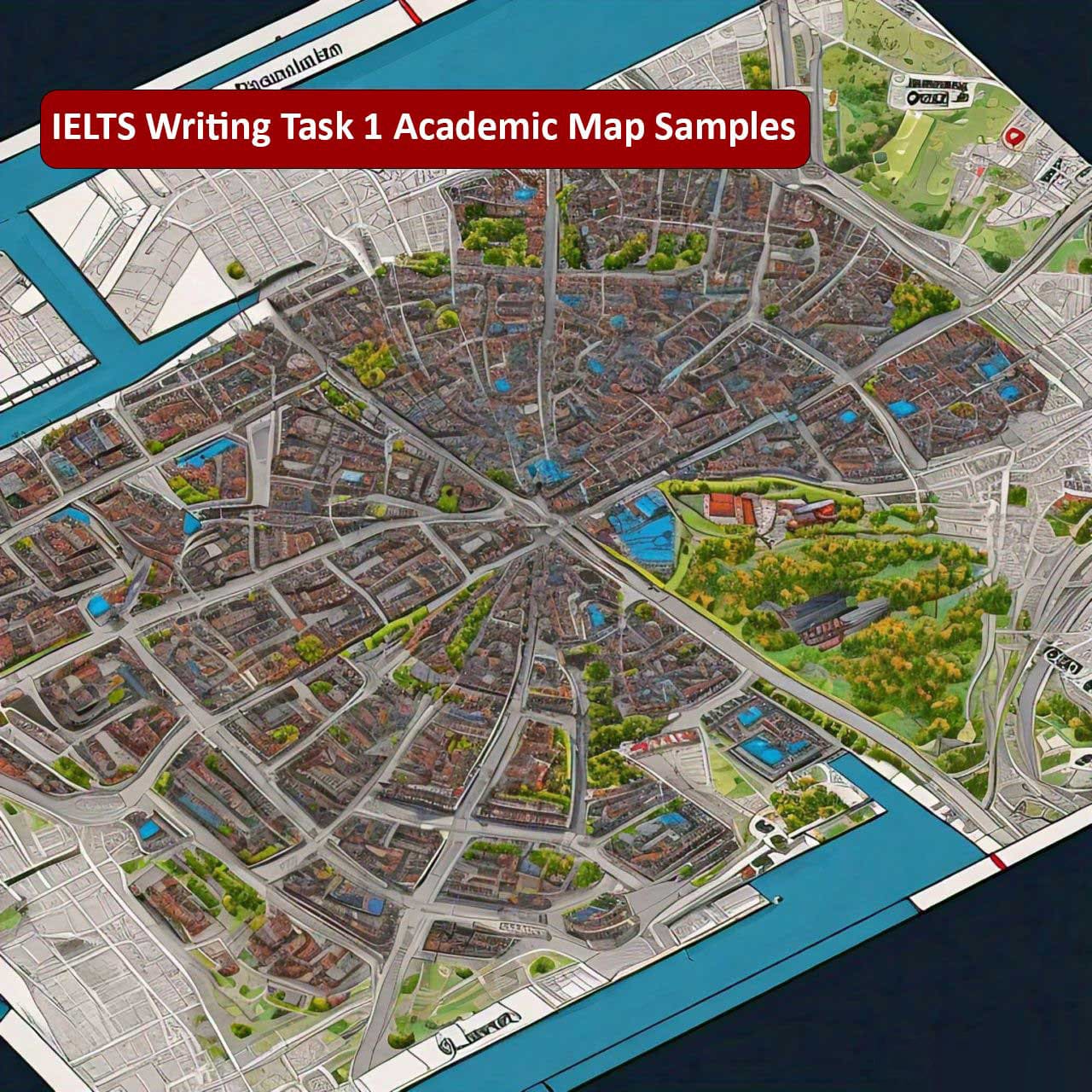In the IELTS Writing Task 1 Academic map module, candidates are required to describe and interpret visual data presented in the form of graphs, charts, tables, or diagrams. One unique type of visual data is the map, which illustrates geographical locations, changes, or developments over time. This task assesses your ability to accurately report information, describe spatial relationships, and identify key features of the map. In this blog post, we will explore the format of IELTS Writing Task 1 Academic maps, provide sample responses, and offer tips to help you excel in this section of the exam.
Table of Contents
Understanding IELTS Writing Task 1 Academic Maps
A map in the IELTS context typically presents a bird’s-eye view of a specific location or area, showing geographical features, developments, or changes over time. Your task is to summarize the information presented in the map, identify significant features or changes, and describe spatial relationships between different elements.
Key Components of an IELTS Writing Task 1 Academic Map
1. Title: Describes the main topic or subject of the map, such as a city, park, or building layout.
2. Key/Legend: Provides explanations for symbols, colors, or markers used on the map to represent different features or areas.
3. Compass: Indicates directions (north, south, east, west) to help orientate the reader.
4. Scale: Shows the ratio between distances on the map and actual distances on the ground.
Now, let’s look at some sample prompts and corresponding responses for IELTS Writing Task 1 Academic maps:
Sample Map Samples
Prompt: The maps below show changes to a town’s layout from 2000 to the present day. Summarize the information by selecting and reporting the main features and make comparisons where relevant.
Sample Response:
The maps illustrate the evolution of a town’s layout from 2000 to the present day.
Overall, significant changes have occurred in the town’s infrastructure and residential areas over the past two decades. In 2000, the town primarily consisted of residential neighborhoods in the northern and central parts, with a small commercial district near the town center.
By the present day, extensive development has transformed the town. The residential areas have expanded to the east and west, with new housing developments and suburban communities replacing agricultural land. The commercial district has also expanded significantly, with new shopping centers and office buildings now located in the southern part of the town.
In addition, new infrastructure such as highways and public transport routes have been constructed to accommodate the growing population and increasing urbanization.
In conclusion, the maps illustrate the urban growth and development of the town over the past two decades, showcasing changes in residential areas, commercial expansion, and infrastructure improvements.
Prompt: The maps below show the development of a university campus from 1990 to the present day. Summarize the information by selecting and reporting the main features and make comparisons where relevant.
Sample Response:
The maps depict the evolution of a university campus from 1990 to the present day.
In 1990, the university campus consisted of a main academic building surrounded by several smaller buildings for classrooms and student facilities. There were also open green spaces and sports fields located to the south of the main academic area.
Over the years, the campus has undergone significant expansion and development. New academic buildings, dormitories, and research facilities have been constructed, particularly in the eastern and western parts of the campus. The original sports fields have been expanded and upgraded, now including a new stadium and recreational facilities.
In addition, the campus has improved its infrastructure with new roads, parking lots, and pedestrian walkways to enhance accessibility and connectivity between different areas.
In conclusion, the maps highlight the growth and transformation of the university campus over several decades, showcasing new construction, expanded facilities, and improved infrastructure.
Tips for Excelling in IELTS Writing Task 1 Academic Maps
1. Understanding the Prompt: Carefully read and understand the prompt to ensure you address all aspects of the task.
2. Describing Changes: Identify and describe significant changes, developments, or expansions shown in the maps.
3. Making Comparisons: Compare the differences between different time periods or areas depicted in the maps to highlight changes or developments.
4. Organizing Your Response: Structure your response logically with an introduction (paraphrasing the prompt), body paragraphs (describing main features and changes), and a conclusion (summarizing key points).
5. Using Spatial Language: Use descriptive language related to spatial relationships, such as “to the north,” “adjacent to,” “surrounded by,” etc., to accurately describe the map features.
By practicing with these sample maps and following the tips provided, you can enhance your skills in describing and analyzing visual data for IELTS Writing Task 1 Academic maps. Regular practice, reviewing feedback from teachers or peers, and focusing on improving your coherence and accuracy will help you achieve success in this section of the exam. Best of luck!
This blog post aims to guide you through the process of effectively interpreting and describing maps for IELTS Writing Task 1 Academic, offering practical examples and actionable tips to boost your preparation and confidence on test day. For more writing related posts, check our IELTS Writing section.



